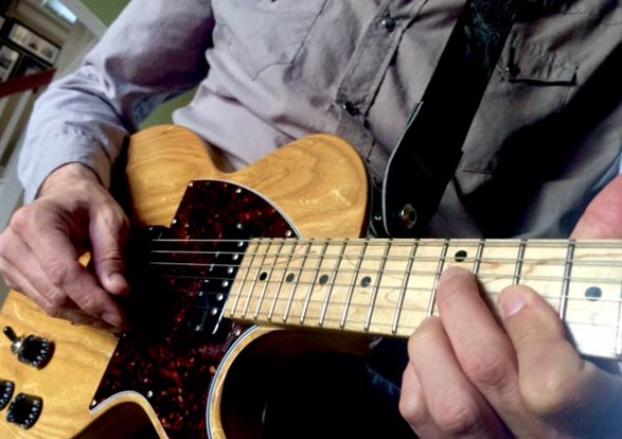Four Ways to Practice Drop 2 Chords Through the Cycle of 4ths

Learning to play dominant 7th chords and Drop 2 chord voicings is essential in the development of any jazz guitarist.
While both of these concepts are important to have under your fingers, running them through exercises such as inversions or chromatically across the neck, although productive exercises, can sometimes lead to boredom in the practice room. Because of this, one of the ways I like to practice and teach these chords is to run them through all 12 keys by using the cycle of 4ths.
With this approach, you not only get all of these chords under your fingers, but you see them used in a progression that moves across the entire neck, you learn to alternate inversions within the context of multiple keys, and you begin to see how these inversions relate to each other when applied to a multi-key cycle.
In this article, we’ll explore four ways that you can practice Drop 2 chords through the cycle of 4ths, learning all four inversions of these chords in 12 keys along the way.
For the sake of space, I have only written these exercises on the middle four strings, so make sure to take them to the top and bottom four-string sets as well when you explore these exercises further in your practice room.
Cycle of 4ths
The cycle used in this exercise to move through all of the 12 keys is called the cycle of 4ths. For those that are familiar with the cycle of 5ths, this is just that cycle but moving in reverse. As the name suggests, each interval between two different chords in the cycle is a Perfect 4th, which continues through all of the keys until you return to your starting note.
Here is how the cycle looks starting on the note G. G – C – F – Bb – Eb – Ab – Db – Gb – B – E – A – D – G
Notice that each chord moves down by the interval of a Perfect 4th, creating the Cycle of 4ths mentioned above. This sequence is beneficial for practicing chord voicings, as compared to simply playing them chromatically up or down the neck, because it forces you to think about which chord is next in the sequence, as well as allowing you to move between multiple inversions as you progress through all 12 keys in the cycle. Now that you have a short background on the Cycle of 4ths, let’s take a look at how you can use this cycle to learn and practice Drop 2 Dominant 7th chords.
Root Position and 2nd Inversion Drop 2 7th Chords
We are going to start these exercises with a root position G7 chord and work it through all 12 keys using the cycle of 4ths as seen above. When doing so, a pattern starts to emerge, which is the alteration of root position (tonic in the bass) and 2nd inversion (5th in the bass) chords as you move down the neck. Knowing this can help you memorize this exercise and quickly find the closest next chord in the sequence. Here is how this exercise looks on paper. Once you have it down starting on G7, try starting this same exercise on all the other 11 7th chords in the sequence and work your way around the cycle of 4ths from all 12 possible root notes.

One of the cool side effects of alternating root position and 2nd inversion chords is that you can do the reverse and it will also work out on the fretboard. So, you can start this exercise on a 2nd inversion chord, such as C7 in the example below, and then alternate 2nd inversion and root position chords around the cycle of 4ths to cover all 12 keys on the neck.

This means that you if you learn the root-2nd inversion alternating exercise, you have already learned the 2nd inversion –root position alternating exercise at the same time, effectively getting twice as much bang for your buck in the woodshed.
1st and 3rd Inversion Drop 2 7th Chords
You can also work on drop 2 chords through the cycle of 4ths by alternating 1st (3rd in bass) and 3rd (7th in bass) voicings down the neck. In the following example you can see that the first chord, F7, is in 1st inversion and the second chord, Bb7, is in 3rd inversion, with this pattern continuing down the neck through all 12 keys in the cycle of 4ths.

In the same way that you double-dipped with the root position and 2nd inversion chords, if you start this exercise on the 3rd inversion and alternate it with the 1st inversion you can work your way through all 12 keys in the cycle of 4ths without having to learn anything new. Here is how that would look starting with a Bb7 chord in 3rd inversion.

After you have explored these chords by starting in different keys, adding in rhythmic variety and bringing them to a tune that has these changes, such as “Jordu” or the bridge to “Rhythm Changes,” try applying these same exercises to Drop 2 chords on the top and bottom four strings of the guitar.
Running 7th chords through the cycle of 4ths will not only help you get these drop 2 chords under your fingers, but they will help you to see your neck better and train your ears to hear this commonly used bass movement, cycling in 4th intervals, all of which can help you reach the next level in your development as a jazz guitarist.
Do you have a favorite way to practice Dominant Cycles? If so, share it in the comments section below.
Matt Warnock is the owner of mattwarnockguitar.com, a free website that provides hundreds of lessons and resources designed to help guitarists of all experience levels meet their practice and performance goals. Matt lives in the UK, where he is a senior lecturer at the Leeds College of Music and an examiner for the London College of Music (Registry of Guitar Tutors).
Get The Pick Newsletter
All the latest guitar news, interviews, lessons, reviews, deals and more, direct to your inbox!
Matt Warnock is the owner of mattwarnockguitar.com, a free website that provides hundreds of lessons and resources designed to help guitarists of all experience levels meet their practice and performance goals. Matt lives in the UK, where he teaches Skype guitar students all over the world, and is an examiner for the London College of Music (Registry of Guitar Tutors).







![Joe Bonamassa [left] wears a deep blue suit and polka-dotted shirt and plays his green refin Strat; the late Irish blues legend Rory Gallagher [right] screams and inflicts some punishment on his heavily worn number one Stratocaster.](https://cdn.mos.cms.futurecdn.net/cw28h7UBcTVfTLs7p7eiLe.jpg)


